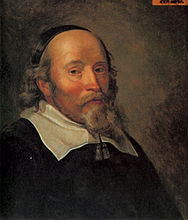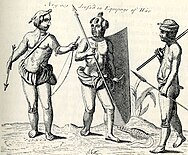| Capture of Carolusborg (1658) | |||||||||
|---|---|---|---|---|---|---|---|---|---|
| Part of Dano-Swedish War (1657–1658) | |||||||||
 Fort Carolusborg, built on the initiative of Hendrik Carloff | |||||||||
| |||||||||
| Belligerents | |||||||||
|
|
Fetu Kingdom Rebellious slaves | ||||||||
| Commanders and leaders | |||||||||
|
|
Acrosan Hennique | ||||||||
| Units involved | |||||||||
|
|
| ||||||||
| Strength | |||||||||
|
16 men 1 ship |
40–50 Dano-Norwegians 50–60 Dutch remidors 22 Dutch sailors 100 Fetu natives 4 boats Total: 190–210 men | ||||||||
| Casualties and losses | |||||||||
|
Entire garrison surrendered 1 ship captured | Negligible | ||||||||
| Swedish colonial conflicts | |||||||||||||||||||
|---|---|---|---|---|---|---|---|---|---|---|---|---|---|---|---|---|---|---|---|
| |||||||||||||||||||
| Danish colonial conflicts | |
|---|---|
| Baltic Sea
North Atlantic Africa
Asia
Caribbean |
| Dano-Swedish War (1657-1658) | |
|---|---|
|
|
The capture of Carolusborg (1658) was a capture by the newly recruited Hendrik Carloff of the Swedish fort of Carolusborg on the Gold Coast.
Background
Founder Louis De Geer the Elder. 1587-1657 by David Beck
Louis De Geer the Elder. 1587-1657 by David Beck
Establishment of the Swedish Africa company
In 1649, the Swedish African company would be created by Louis De Geer along with his son Laurens and other nobles with the privilege to trade slaves, gold and ivory with a letter of privilege issued by Queen Christina. The majority of the share in the company was held by De Geer while others such as Gustaf Horn, Johan Adeler Salvius, and Peter Julius Coyet held smaller shares.
1650 expedition
In 1650, the two ships, Christina and Stockholms Slott were prepared for an expedition into Africa. Queen Christina excitedly attended the preparations. The ships were loaded with fabrics, copper, iron, tin,
glass beads, knives, mirrors and brandy in order to conduct trade on the Gold coast. When the ships arrived, the Swedes set up a trading post and returned to Sweden with gold, ivory and sugar.
An aide to De Geer, a man named Hendrik Carloff, was appointed governor of the colony, and quickly began preparations to construct a fortress.
Establishment of Carolusborg
Map Historic map of the coast of West Africa, then called "Guinea", c. 1725 by Herman Moll
Historic map of the coast of West Africa, then called "Guinea", c. 1725 by Herman Moll
After he had arrived on the Gold coast on 22 April 1650, Carloff quickly began working to renew an agreement that had previously been signed by a certain Gabbesen with King Bredeva of the Fetu. After this, despite protests from other natives he began construction of a fort he named Carolusborg.
Hendrik Carloff's defection
In 1656, a feud between Hendrik and the Swedish Africa company rose up, and he later resigned in anger and offered his services to the Danish king, Frederick III after the Dano-Swedish War had broken out earlier, he was assigned a mission to capture Carolusborg from the Swedes.
Capture
Fetu warriors Representations of Fetu Warriors by Edmund Halley
Representations of Fetu Warriors by Edmund Halley
On December 1, after signing an agreement with the Danish king, Carloff began sailing to the Gold coast from Glückstadt harbor. When he arrived at Gemoree on January 25, he showed the Swedish colors which prompted the local Swedish agent to send a man to him. However, Carloff detained the man in order to extract information from him about Carolusborg. From the information he received, he quickly sailed over to the nearby Fort Axim controlled by the Dutch to ask for help in taking the fortress. The Dutch quickly agreed to help Carloff, giving him 4 boats, 50-60 Remidors, and 22 sailors. During a march towards Carolusborg in the night, Carloff sent messages to all neighbouring tribes requesting aid in expelling the Swedes. The most important person he contacted was the brother of the King of the Fetu, Hennique. He was able to persuade the African chief to promise aid to Carloff, and under the cover of night he let Carloff into Ogua where the chief called together the slaves under the Swedish African company and promised them riches if they offered their assistance.
In the next morning, a dense fog covered the surrounding area of Carolusborg, and after the company slaves had picked up their tools and entered the fortress they knocked down a Swedish sentry and announced that those who didn't show resistance would receive their pay as normal. They also opened the gate allowing for the Dutch sailors and around 100 natives entered. Since the Swedish garrison only consisted of 16 men, resistance was all but futile. The Swedish commander and governor, Johann Philipp von Krusenstjerna, was captured along with the captain of the Stockholms slott when Johann was forced to lure him into the fortress. The Dutch support troops were able to persuade the Dutch sailors who made up the majority of the crew on the Stockholms slott to come to them, and since the remaining Swedish crew were not numerous enough to sail away, the Dutch were able to capture it.
Aftermath
The Swedes in the garrison who chose to enter into service under Carloff were permitted to do so, and Carloff gathered them in the hall of the fort and forced them to swear an oath of allegiance to himself and make a written confirmation of it. The Danish flag would eventually be hoisted, and the Danish artillery signal would be fired.
References
- ^ "Svensk historia - Hans Högman". www.hhogman.se. Retrieved 2024-04-17.
- "Kolonin Cabo Corso 1649-1658 - Historiesajten.se". historiesajten.se. Retrieved 2024-04-17.
- "The Swedish Africa Company is Formed". African American Registry. Retrieved 2024-04-17.
- "Svensk slavhandel | Historia | SO-rummet". www.so-rummet.se (in Swedish). 2024-03-26. Retrieved 2024-04-17.
- ^ georg norregard (1966). danish settlements in west africa 1658-1850. Internet Archive.
- ^ Milhist (2013-11-01). "Svenskekrig på Guineakysten -". milhist.dk (in Danish). Retrieved 2024-04-16.
5°06′13″N 1°14′29″W / 5.1036°N 1.2413°W / 5.1036; -1.2413
Categories: